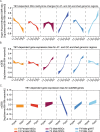Transgenerational Self-Reconstruction of Disrupted Chromatin Organization After Exposure To An Environmental Stressor in Mice
- PMID: 31506492
- PMCID: PMC6736928
- DOI: 10.1038/s41598-019-49440-2
Transgenerational Self-Reconstruction of Disrupted Chromatin Organization After Exposure To An Environmental Stressor in Mice
Abstract
Exposure to environmental stressors is known to increase disease susceptibility in unexposed descendants in the absence of detectable genetic mutations. The mechanisms mediating environmentally-induced transgenerational disease susceptibility are poorly understood. We showed that great-great-grandsons of female mice exposed to tributyltin (TBT) throughout pregnancy and lactation were predisposed to obesity due to altered chromatin organization that subsequently biased DNA methylation and gene expression. Here we analyzed DNA methylomes and transcriptomes from tissues of animals ancestrally exposed to TBT spanning generations, sexes, ontogeny, and cell differentiation state. We found that TBT elicited concerted alterations in the expression of "chromatin organization" genes and inferred that TBT-disrupted chromatin organization might be able to self-reconstruct transgenerationally. We also found that the location of "chromatin organization" and "metabolic" genes is biased similarly in mouse and human genomes, suggesting that exposure to environmental stressors in different species could elicit similar phenotypic effects via self-reconstruction of disrupted chromatin organization.
Conflict of interest statement
B.B. is a named inventor on U.S. patents US 5,861,274, US 6,200,802, US 6,815,168, US 7,250,273, related to PPARγ. C.D.-C., R.C.-G. and T.S. declare no competing financial interests.
Figures




Similar articles
-
Transgenerational Inheritance of Environmentally Induced Epigenetic Alterations during Mammalian Development.Cells. 2019 Dec 3;8(12):1559. doi: 10.3390/cells8121559. Cells. 2019. PMID: 31816913 Free PMC article. Review.
-
Heritable changes in chromatin contacts linked to transgenerational obesity.Res Sq [Preprint]. 2023 Nov 28:rs.3.rs-3570919. doi: 10.21203/rs.3.rs-3570919/v1. Res Sq. 2023. PMID: 38077066 Free PMC article. Preprint.
-
Ancestral perinatal obesogen exposure results in a transgenerational thrifty phenotype in mice.Nat Commun. 2017 Dec 8;8(1):2012. doi: 10.1038/s41467-017-01944-z. Nat Commun. 2017. PMID: 29222412 Free PMC article.
-
Transgenerational metabolomic fingerprints in mice ancestrally exposed to the obesogen TBT.Environ Int. 2021 Dec;157:106822. doi: 10.1016/j.envint.2021.106822. Epub 2021 Aug 26. Environ Int. 2021. PMID: 34455191 Free PMC article.
-
Environmental effects on chromatin repression at imprinted genes and endogenous retroviruses.Curr Opin Chem Biol. 2018 Aug;45:139-147. doi: 10.1016/j.cbpa.2018.04.015. Epub 2018 May 23. Curr Opin Chem Biol. 2018. PMID: 29800804 Review.
Cited by
-
Transgenerational Inheritance of Environmentally Induced Epigenetic Alterations during Mammalian Development.Cells. 2019 Dec 3;8(12):1559. doi: 10.3390/cells8121559. Cells. 2019. PMID: 31816913 Free PMC article. Review.
-
An in vitro approach reveals molecular mechanisms underlying endocrine disruptor-induced epimutagenesis.Elife. 2024 Oct 3;13:RP93975. doi: 10.7554/eLife.93975. Elife. 2024. PMID: 39361026 Free PMC article.
-
An in silico to in vivo approach identifies retinoid-X receptor activating tert-butylphenols used in food contact materials.Sci Rep. 2025 Jul 18;15(1):26102. doi: 10.1038/s41598-025-09244-z. Sci Rep. 2025. PMID: 40681575 Free PMC article.
-
Heritable changes in chromatin contacts linked to transgenerational obesity.Res Sq [Preprint]. 2023 Nov 28:rs.3.rs-3570919. doi: 10.21203/rs.3.rs-3570919/v1. Res Sq. 2023. PMID: 38077066 Free PMC article. Preprint.
-
Transgenerational Transcriptomic and DNA Methylome Profiling of Mouse Fetal Testicular Germline and Somatic Cells after Exposure of Pregnant Mothers to Tributyltin, a Potent Obesogen.Metabolites. 2022 Jan 20;12(2):95. doi: 10.3390/metabo12020095. Metabolites. 2022. PMID: 35208169 Free PMC article.
References
-
- Hales, C. M., Carroll, M. D., Fryar, C. D. & Ogden, C. L. Prevalence of Obesity Among Adults and Youth: United States, 2015–2016. NCHS Data Brief, 1–8. (2017). - PubMed
Publication types
MeSH terms
Substances
Grants and funding
LinkOut - more resources
Full Text Sources
Molecular Biology Databases

